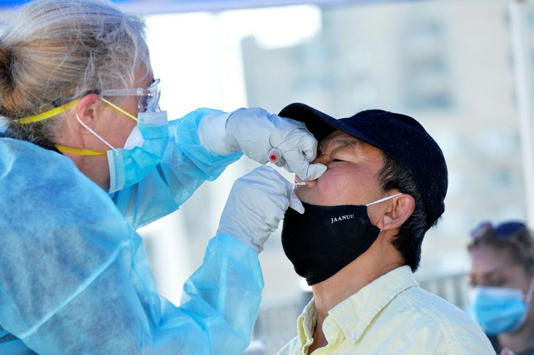PARIS, Aug 19, 2020 (BSS/AFP) – Testing for COVID-19 and tracing the prior
contacts of those found to be infected are crucial measures for slowing the
disease’s spread, but inadequate unless combined with other measures,
researchers said Wednesday.
By itself, the test-and-trace approach can reduce the virus’ reproduction
rate, or R number, by 26 percent, they reported in The Lancet Infectious
Diseases, using mathematical models to examine data from previously published
studies.
The reproduction rate measures the number of people in a population, on
average, infected by each person carrying the virus.
Anything above “1” means the disease is continuing to expand; below that
threshold, it will eventually peter out.
Some countries that brought the spread of COVID-19 under control but are
now struggling to prevent a resurgence have R numbers well above 1.
In France, for example, it hovered at about 1.33 during the first week of
August, according to national health authorities.
But the new finding comes with a caveat, said lead author Nicholas
Grassly, a professor at Imperial College’s School of Public Health.
“Our results show that test and trace can help reduce the R number but
needs to be carried out effectively and quickly to do so,” he said in a
statement.
Concretely, that means immediate testing with the onset of symptoms and
results within 24 hours; the quarantine of contacts, also within 24 hours;
and the identification of 80 percent of cases and contacts.
Very few countries — notably South Korea, Taiwan and Germany — have come
close to staying within these guidelines, and most are still falling well
short.
In France, for example, it generally take days to get an appointment for a
so-called PCR nasal test, and on average 3.5 days for a result, according to
official figures.
– Herd immunity not close –
In the United States and the UK, delays can be even longer.
Even if nations do adhere to these guidelines, it will still not be enough
to bring the infection rate down sufficiently by itself, the new study
concludes.
“Test and trace alone won’t be enough to control transmission in most
communities, and other measures alongside will be needed to bring the R
number below 1,” said Grassly.
Weekly screening of high-risk groups such as health and social-care
workers — regardless of whether they have symptoms or not — can reduce
transmission by an additional 23 percent, his team found.
Experts are still unsure as to what percentage of a population must be
immune — a threshold known as “herd immunity” — to prevent the virus from
continuing to spread.
Estimates range from below 50 to 70 percent.
It is possible that some of the hardest hit regions — New York City,
northern Italy — may be close to these levels, but at a national scale the
numbers are still far lower, probably barely in double digits.
WHO emergencies director Michael Ryan said Tuesday that the planet was
“nowhere close to the levels of immunity required to stop this disease”.
People should “not live in hope of herd immunity being our salvation.
Right now, that is not a solution,” he added.
A vaccine, of course, would also provide immunity, but is unlikely to be
available until next year.
Currently, only people who have fought off COVID-19 and survived have some
degree of immunity, though it remains unclear how robust it is and how long
it lasts.
It is also unclear the extent to which people with mild or asymptomatic
cases have immunity at all.
The novel coronavirus has killed nearly 775,000 people and infected almost
22 million since the outbreak emerged in China last December, according to a
tally from official sources compiled by AFP.



